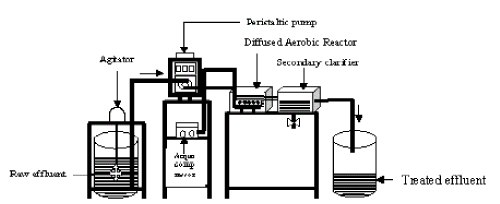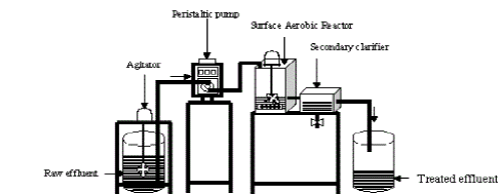Keywords
|
| Attached- growth, Aerobic reactor, Sugar effluent, Diffused aeration |
INTRODUCTION
|
| Sugar mill effluent is highly biodegradable and largely treated in Biological treatment plants. The existing treatment facilities in sugar industries, invariably, require revamping in terms of its process and engineered systems. The biological treatment methods, where bacteria and other microorganisms are used to remove contaminants by assimilating them-has long been a mainstay of wastewater treatment in the sugar mills. |
| The aeration systems are the utmost important while treating high COD, biodegradable waste streams. The aerobic methods viz; surface and diffused, do have their own exclusive advantages. The present experimental model was envisaged to test both the methods of aeration over the experiment, for treating sugar mill effluent. |
EXPERIMENTAL SETUP
|
| The nuclei of the experimental setup is an attached - growth aerobic reactor having nine liters of effective volume. The physical and process parameters of the experimental model are listed in Table.1. The schematic of the experimental setup is presented in Fig. 1 and 2. |
| The surface aeration is incorporated in the model using a turbine blade ( 9 cm dia ) that get energized by 85 watts motor. The impeller speed was controlled for the rotational speed of 100 to 150 rpm. The diffused aeration is incorporated by diffusing air through a porous ( pore dia 0.003 m; 54 numbers ) stainless steel pipe ( 0.019 m dia ) and air was supplied at 15 litres/minute from an aqua blower. The clarifier system is having a surface area of 0.09 sq.m. A peristaltic pump is used to regulate the influent flow rate of effluent. |
EXPERIMENTAL METHODOLOGY
|
| The sugar effluent samples were obtained from M/s. MRK Co-operative Sugar Mill, Sethiyathope and analyzed for critical parameters. The synthetic preparation is simulated on the basis of analyzed parameter values of the samples. Synthetic effluent streams are used for the experimental works. |
| The model was initiated with domestic wastewater and sugar effluent was fed in parts and process acclimatization was achieved for synthetic sugar effluent stream over a period. The experiment was conducted for different operating conditions, viz; varying flow rate, and varying influent COD. |
| The operating conditions are interpreted for the model – specific hydraulic retention times (HRT, hrs) and organic loading rates (OLR, Kg COD/ m2.day) |
RESULTS AND DISCUSSION
|
| The COD removal efficiency under varying organic loading rates ( 0.0047 to 0.1244 Kg COD/m2.day ) for different influent COD (1015.16, 1531.85, 2031.64, 2522.16 and 2996.72 mg/L ) are presented in figures 2.1, 2.2, 2.3, 2.4 and 2.5 for treating sugar mill effluent using surface aeration. |
| The COD removal efficiency under varying organic loading rates ( 0.0047 to 0.1244 Kg COD/m2.day ) for different influent COD ( 1015.16, 1531.85, 2031.64, 2522.16 & 2996.72 mg/L) are presented in figures 2.1, 2.2, 2.3, 2.4 and 2.5 for treating sugar mill effluent using diffused aeration. |
| The COD removal efficiency under varying hydraulic retention time (48, 24,18,12 & 06 hrs ) for different influent COD ( 1015.16, 1531.85, 2031.64, 2522.16 and 2996.72 mg/L ) are presented in Figs. 3.1, 3.2, 3.3, 3.4 and 3.5 for treating sugar mill effluent using diffused aeration and surface aeration. |
Conclusion
|
| The maximum COD removal efficiency of 93.57% was observed, while the model was run using diffused aeration. This is higher than 88.66% of COD removal efficiency, which was observed in similar conditions of experiment for surface aeration. Hence, it can be concluded that diffused aeration is preferable in place of surface aeration |
| |
Figures at a glance
|
 |
 |
 |
| Figure 1 |
Figure 2 |
Figure 3 |
|
| |
References
|
- Connie, D., Demoyer, Erica, L. Schierhotz, John Gulliver, S. 2003. Impact of bubble and free surface oxygen transfer on diffused aeration systems. Water Research. 37 ( 8) : 1890-1904.
- Lee, M., Kang, J., Lee, C.H., Haam, S., Park, H.H., Kim, W.S. 2001. Oxygen transfer characteristics in a pilot scale surface aeration vessel wiyhsimcar aerator. Environ tecnol. 22 (1) : 57-68.
- Metcalf and eddy, INC. 2003. Wastewater Engineering Treatment and Reuse. Tata Mc- Graw-hill Pub. Co. Ltd, New Delhi fourth edition.
- Monteith, H,D., Bell, J.P., Parker, W.J., Meicer, H. Harvey, R.T. Effect of bubble-induced surface turbulence on Gas –Liquid mass transfer in diffused aeration systems. Water Environment Research. 77 ( 2) : 128-137.
- Rieger, L., Abex, J., Guger, W. and Siegrist, 2006. Modelling of aeration systems at wastewater treatment plants. Water Science & Technology. 53 (4-5) : 439- 447, IWA Publishing .
- UdayaSimha, L.2001. Effect of tank shape on surface aeration. International Conference on Civil Engineerimg, IISC, Bangalore, Interline Publishing. 759-763.
|